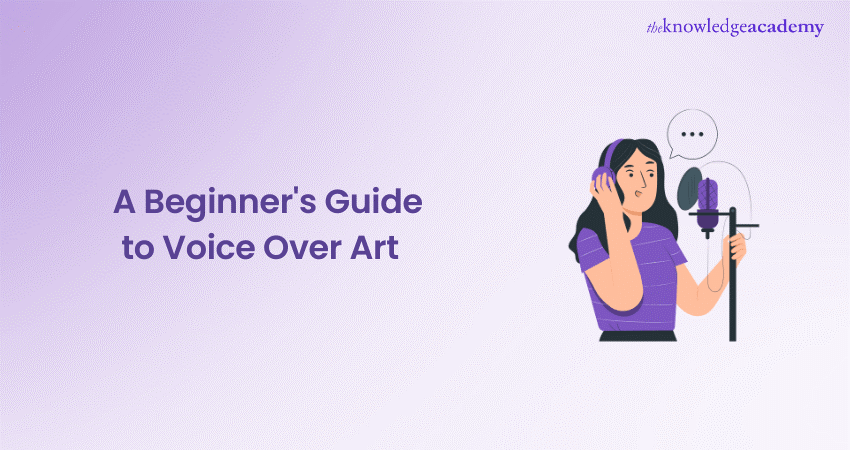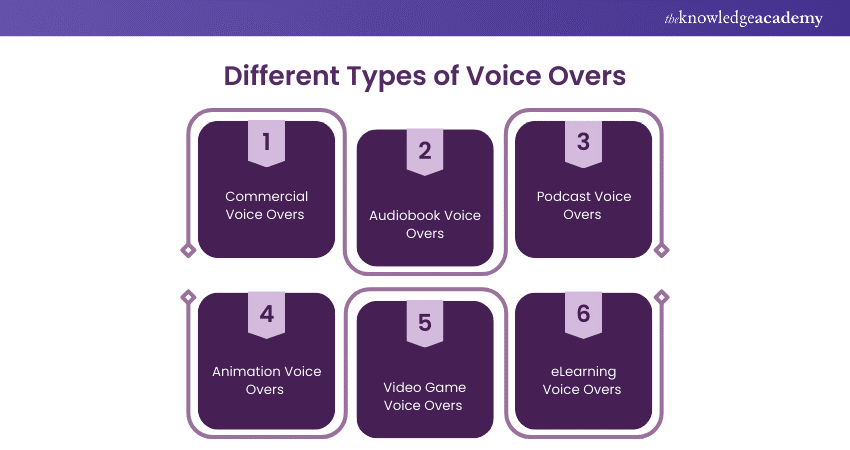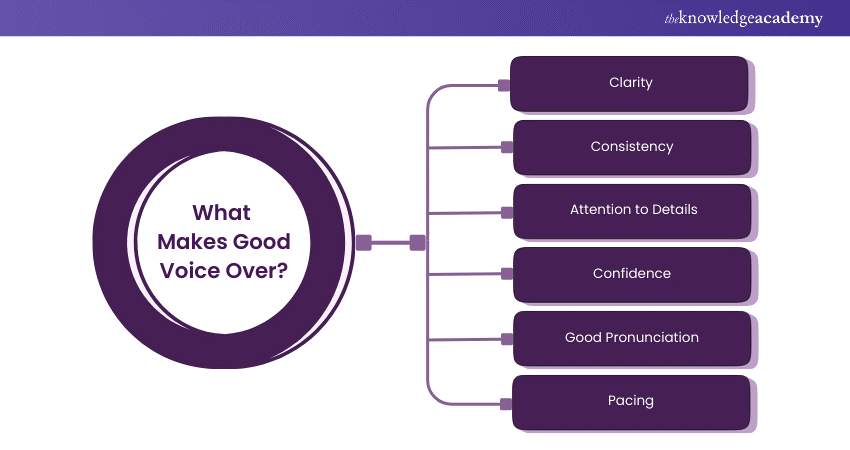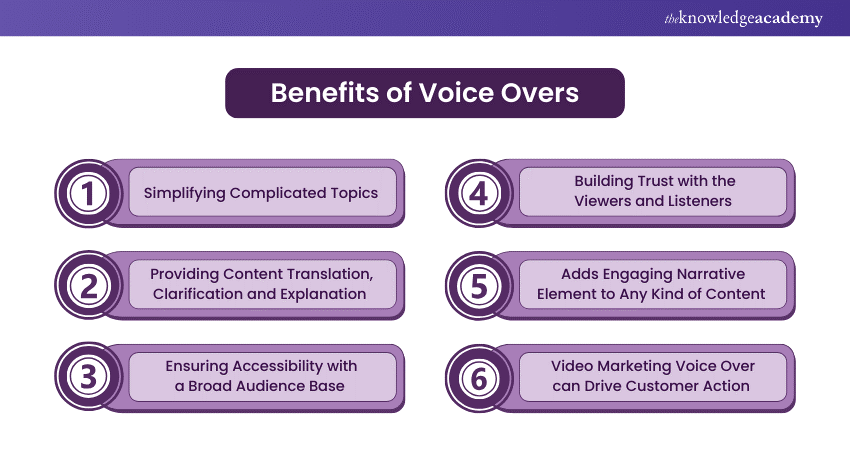We may not have the course you’re looking for. If you enquire or give us a call on 01344203999 and speak to our training experts, we may still be able to help with your training requirements.
We ensure quality, budget-alignment, and timely delivery by our expert instructors.

A human voice possesses tremendous narrative power and nowhere is it more pronounced than in the art of Voice Over recordings. In a world saturated with a dizzying range of multimedia content, the importance of an engaging voice cannot be overstated.
Whether you are producing video ads, audiobooks, explainer animation videos, podcasts, YouTube videos or any form of media can tremendously influence the underlying message. This is where the craft of voice-over takes centre stage. So, whether you're looking to educate, market, or entertain, incorporating a great Voice Overs can take your content to the next level.
Table of Contents
1) What is a Voice over?
2) The Purpose of Voice Overs
3) The History of Voice Overs
4) Different Types of Voice Overs
5) Key Elements of Quality Voice over Work
6) Tips for Performing Voice Overs
7) Benefits of Voice Overs
8) Voice over vs. Voice Acting: What is the Difference?
9) Conclusion
What is a Voice Over?
A Voice Over (often abbreviated as VO in script notation) is a narrative technique where an unseen actor's lines are heard over visual elements in a film or commercial. The announcer introducing a talk show host, or the narrator of a documentary are examples of voice over artists.
By eliminating the need for a visible spokesman, this approach allows for more time to showcase the product in a commercial or visually set up a movie’s storyline. Typically, a person acts the script in a recording studio.
The Purpose of Voice Overs
Voice Overs serve various exciting purposes which includes:
1) Narration
In films and television, Voice Overs are used to narratively connect scenes or explain a character's thoughts or motivations. A classic example is the use of Voice Overs in the film noir genre.
2) Messaging in Commercial/Advertising
In radio and television commercials, Voice Overs are employed to convey messages and sell products or services.
3) News Reporting and Documentaries
Voice Overs provide information and commentary about the visual content in documentaries and news reports.
4) Animation and Video Games
Voice actors provide voices for characters in animated films and video games. This is one of the most creative usage of Voice Overs.
5) Audiobooks
A voice actor or narrator reads the entire text of an audiobook aloud.
6) Training and Education
Voice Overs in training or educational videos and presentations help to instruct or guide viewers.
The quality of the voice over has a significant impact on the content's effectiveness. The voice actor must convey the right emotions and nuances as dictated by the script. Additionally, the recording and mixing processes must be done professionally for the best results.
Looking to expand your Voice Overs creativity? Sign up for our Voice Overs Course today
The History of Voice Overs
1) Voice Overs can be traced back to 1906 when inventor Reginald Fessenden essentially discovered AM radio by broadcasting his voice to ships at sea from Massachusetts.
2) Throughout the early 1900s, Voice Over was primarily used in radio, and in 1922 this medium got significantly elevated with the creation of the British Broadcast Company. This was a private broadcaster that later became public and played a pivotal role in increasing global interest in radio.
3) Radio's popularity led to the advent of radio dramas, marking a significant turning point for voice-over. These voice-only shows (predecessors of audiobooks and podcasts) became hugely popular between the 1920s and 1940s.
4) In 1938, Orson Welles famously demonstrated the power of effective voice performance through his radio production of H.G. Wells’ “The War of the Worlds”. Impressively, this performance convinced listeners that the fictional broadcast was real.
5) Animation entered the Voice Overs landscape in 1928 with the release of Disney’s animated short “Steamboat Willie.” This is one of the first cartoons to synchronise sound with images, in addition to Walt Disney himself providing the voice of Mickey Mouse.
6) The 1940s and 1950s saw the use of Voice Overs narration significantly in the film noir genre.
Different Types of Voice Overs
Here are the different types of Voice Overs:

1) Commercial Voice Overs
Commercials are designed to capture the viewer’s attention quickly. Whether promoting a product or cause, the voice actor must convey the advertisement's message. These Voice Overs are concise, and the actor infuses energy and emotion into the script to engage and inform the audience.
2) Audiobook Voice Overs
Audiobook Voice Overs bring an author's book to life through the actor's performance. This requires a thorough understanding of the text, including its tone, narrative arc and characters.
Audiobook narrators are skilled storytellers who captivate listeners for hours by modulating their voice to represent a variety of characters and emotions.
3) Podcast Voice Overs
Based on the format and content, a podcast's Voice Overs can vary greatly. Podcasters may serve as interviewers, hosts, narrators or commentators, discussing topics such as news, entertainment, and personal stories.
The tone of podcasts is conversational yet engaging, and blends information with entertainment to maintain listener interest.
4) Animation Voice Overs
Voice Overs for animation is prevalent in television, film and commercials. Animation is a medium rather than a genre and that’s why animation Voice Overs encompass a wide array of projects.
These projects range from children's shows like “Paw Patrol” to adult animation such as "The Simpsons," and dubbing for anime series like "Pokemon."
Actors develop unique voices that match the characters' personalities. This type of Voice Over requires immense versatility and the ability to convey multiple emotions solely through voice.
5) Video Game Voice Overs
Voice Overs plays a vital role in immersing players in the world of a video game. From the small sniffs and grunts of a character walking across a terrain to full-on performances in cutscenes, Voice Overs are the key to a great gaming experience.
6) eLearning Voice Overs
This type of voice-over facilitates learning through online tutorials, courses, and training modules. Voice Overs artists in educational content adopt a less charismatic or energetic tone compared to those in commercials or animation. Their work needs to be clear and well-paced to ensure viewers can understand the material.
Learn how to stand out in the world of Podcasting through our Podcasting Course - Sign up now!
Key Elements of Quality Voice Overs Work
Anyone can set up a home studio and begin doing amateur voice work. However, to become an exceptional voice actor, it's important to grasp the concept of great Voice Over performance.
Here the main elements of high-quality Voice Overs work:

1) Clarity
Volume and sound quality are essential for a good Voice Overs production. Your voice should be clear and recorded at a comfortable volume. Any background noise or difficulty in hearing your voice can result in listeners losing interest.
2) Consistency
A professional Voice Over artist delivers consistency in performance. If every recording sounds different, there may still be room for improvement. Top voice actors ensure consistent quality, thus helping them secure more jobs.
3) Attention to details
Most of us are oblivious to the subtle noises our mouths make while speaking. That is a big deal when it comes to Voice Overs recording as even the slightest sounds can ruin a recording session.
We may not be aware of the small breaths that goes with every word or an unexpected sigh in the middle of a sentence. But an exceptional Voice Overs talent will identify and eliminate these issues.
4) Confidence
Confidence in vocal abilities is vital for a high-quality Voice Overs work. Voice actors must follow the script while infusing their personality into the performance. It's imperative for them to sound convincing when delivering lines.
5) Good pronunciation
While both enunciation and pronunciation are crucial for a good Voice Overs work, they have a big difference.
Pronunciation involves saying a word correctly with the proper accentuation, while enunciation ensures the word is spoken clearly so that any listener can understand.
6) Pacing
Good pacing is the key to delivering the script on cue. The ideal pace will differ for different projects, such as commercials, documentaries or explainer videos. Experienced voice actors know how to adjust their pace to fit each specific project.
Tips for Performing Voice Overs
Whether you are creating a Voice Overs yourself or guiding an artist, Voice Overs are fun. Use the following tips to ensure the best performance for your story:
1) Practice and warm-up
Just like athletes stretch before a game, voice artists need their own form of warm-up. singing scales, reciting tongue twisters or even humming can be good warm-up exercises.
Humming along to your favourite song relaxes your throat muscles, preparing you for recording. This practice helps in enunciation, which is an essential element of or voice-over narration.
2) Understand the script and audience
Before you start recording, ensure that you understand the message, tone and target audience. The tone used for narrating a children's story will differ considerably from that of a corporate training video.
For example, what if you read "Once upon a time, in a land far away..." with the same seriousness as "Safety protocols are essential in the workplace"? It clearly doesn't have the same ring to it.
3) Use proper mic technique
Your connection to the microphone can make or break your recording. It's important that you stay about 6 inches from your microphone during a session.
Moving too much will cause volume inconsistencies. When you are emphasising a point, don't lean in closer, simply adjust the volume of your voice. Also, while hand gestures are helpful, make sure you don’t bump the microphone in the process.
4) Control your breathing
When it comes to Voice Overs recordings, breathing is everything. Its’ important to take deep breaths from your diaphragm (not your chest). This ensures a steady airflow and reduces unwanted breathy sounds.
For lengthy sentences, plan your breaths to avoid running out of air mid-sentence. This will require a few practice rounds to perfect.
5) Master editing and post-production
Post-production is just as crucial as recording in a Voice Overs work. Remove unwanted noises, adjust volume levels and add effects if necessary.
While you don't need a professional recording studio to edit skilfully, having the right tools can enhance the editing process. These tools can clean up audio by removing loud breaths or background noises like chair squeaks.
Benefits of Voice Overs

When creating thumb-stopping videos, adding a Voice Overs can give significant benefits for any business or creative. Consider these benefits of Voice Overs:
a) Simplifying complicated topics
b) Providing content translation, clarification and explanation
c) Ensuring accessibility with a broad audience base
d) Building trust with the viewers and listeners
e) Adds engaging narrative element to any kind of content
f) Video marketing voice over can drive customer action
Voice Overs vs. Voice Acting: What is the Difference?
While the terms "Voice Overs" and "Voice acting" are often used interchangeably, they have slightly different meanings.
Voice Overs
As previously mentioned, Voice Overs is a broad term referring to the use of off-screen voices in media productions. It is utilised in various contexts, including documentaries, commercials, promotional videos and instructional materials.
The voice over artist typically remains unseen by the audience and could be voicing animated characters, delivering narration or speaking in commercials.
Voice acting
On the other hand, voice acting a subset of Voice Overs work. It’s the art of bringing characters to life through vocal performance in media such as animated movies, radio dramas, video games and more.
Voice acting is not just reading lines but embodying a character and conveying personality and emotions through the voice alone. Voice Over vs Voice Acting highlights this difference, as it requires a wide range of acting skills and the ability to create distinctive and engaging character voices.
Essentially, all voice acting is a form of Voice Overs, but not all Voice Overs is voice acting. Some Voice Overs roles do not require traditional "acting” methods. As an example, take the case of a commercial. The artist usually don’t portray a character but rather presents information and persuades the audience about a product or service.
Conclusion
Voice Overs work takes as much skill as other forms of performance art. It’s the go-to tool for creative minds in the world of media and entertainment. We hope this blog helps you understand the significance of Voice Overs work and the skills needed to master it.
Develop the skill of good audio transcription. Sign up for Audio Transcription Course - Register now!
Frequently Asked Questions
What are Voice Overs services?

Voice Overs services use Voice Overs techniques as a solution for businesses, content creation and individuals looking to add an engaging touch to their projects.
What is needed for Voice Overs work?

For Voice Overs work, you will need various resources. This includes a storage device (Like laptop), professional grade microphone, editing software, good acoustics in the studio, clear pronunciation and voice improvisation skills among others.
What are the responsibilities of a Voice Overs?

A Voice Overs talent is responsible for providing voice recordings for media including corporate training videos, television, radio advertisements, documentaries, animation etc.
What are the Other Resources and Offers Provided by The Knowledge Academy?

The Knowledge Academy takes global learning to new heights, offering over 3,000 online courses across 490+ locations in 190+ countries. This expansive reach ensures accessibility and convenience for learners worldwide.
Alongside our diverse Online Course Catalogue, encompassing 19 major categories, we go the extra mile by providing a plethora of free educational Online Resources like News updates, Blogs, videos, webinars, and interview questions. Tailoring learning experiences further, professionals can maximise value with customisable Course Bundles of TKA.
What is The Knowledge Pass, and How Does it Work?

The Knowledge Academy’s Knowledge Pass, a prepaid voucher, adds another layer of flexibility, allowing course bookings over a 12-month period. Join us on a journey where education knows no bounds.
What are the Related Courses and Blogs Provided by The Knowledge Academy?

The Knowledge Academy offers various Personal Development Courses, including Voice Overs artist courses, Podcasting and audio transcription course. These courses cater to different skill levels, including providing comprehensive insights into developing Voice Overs Skills.
Our Business Skills Blogs cover a range of topics related to Earned Value Management, offering valuable resources, best practices, and industry insights. Whether you are a beginner or looking to advance your Project Management skills, The Knowledge Academy's diverse courses and informative blogs have got you covered.
Upcoming Business Skills Resources Batches & Dates
Date
 Voice Over Artist Course
Voice Over Artist Course
Fri 2nd May 2025
Fri 4th Jul 2025
Fri 5th Sep 2025
Fri 7th Nov 2025






 Top Rated Course
Top Rated Course



 If you wish to make any changes to your course, please
If you wish to make any changes to your course, please


